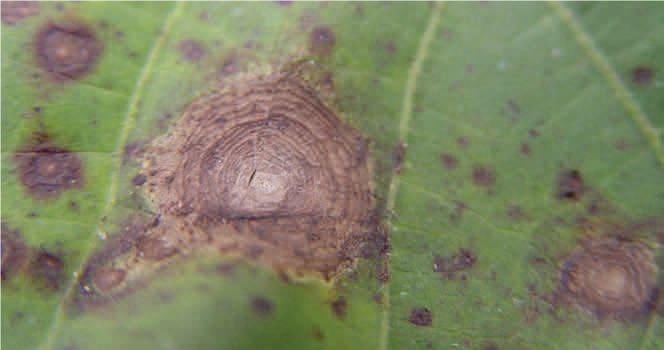We have been receiving rain from Tropical Storm Elsa as she moved through our area. Field activity has been delayed. Prior to the storm, many growers were making applications for weed control and diseases. While the rain has been good for our crops, we expect disease pressure to be on the increase. Growers should remain on a good fungicide spray schedule in peanuts for leaf spot and white mold.
Southern corn rust has been confirmed in Worth County. Much of the corn in the county has reached the hard dough/dent stage of growth, but later planted corn that has not reached that stage of maturity is still vulnerable. Below is a picture of southern corn rust.
Some cotton in the county is already blooming. Growers with blooming cotton should be thinking about target spot. See the picture below of target spot in cotton.

Following is an excerpt from Dr. Kemerait regarding target spot in the July Cotton Team Newsletter:
Conditions in July Favorable for Target Spot (Bob Kemerait): “Target spot is a foliar disease of cotton caused by the fungal pathogen Corynespora cassiicola. The symptom most characteristic of this disease are numerous lesions, often with concentric rings (hence the name “target spot”) that develop first on the leaves lower in the canopy. The target-like spots initially develop lower in the canopy for several reasons. First, these are older leaves have had longer exposure to the fungal spores. Second, the pathogen survives in the debris from previous cotton crops, so the spores can be spread from the debris to the lower leaves through rain splash and irrigation. Third, spores of Corynespora cassiicola require a prolonged leafwetness periods (perhaps as long as 12-14 hours) for infection to occur, which is most likely deeper in the canopy where humidity is higher. Significant defoliation can happen within two weeks after the first spots are observed if conditions are favorable (warm, humid, and moist). Boll development can be affected when pre-mature defoliation removes the leaves feeding younger bolls.
UGA Extension does not have a blanket recommendation for treating a cotton crop with a fungicide to control target spot, though when this disease occurs early enough, growers can expect losses of lint to reach 200 lb/A (or more). Growers are advised to begin carefully scouting a cotton crop at the approach of the first week of bloom, checking the lower canopy for tell-tale symptomatic leaves. If target spot is not identified after careful scouting, growers may delay a fungicide application and scout again in the coming weeks. From our research, the best timing of a fungicide application is often during the third week of bloom; where disease pressure is high, a second application may be beneficial two weeks later. Fungicides are not needed after the sixth week of bloom.”
If we can be of assistance to you at Worth County Extension, let us know.

